It’s a Cascade of 14nm CPUs: AnandTech’s Intel Core i9-10980XE Review
by Dr. Ian Cutress on November 25, 2019 9:00 AM ESTCPU Performance: System Tests
Our System Test section focuses significantly on real-world testing, user experience, with a slight nod to throughput. In this section we cover application loading time, image processing, simple scientific physics, emulation, neural simulation, optimized compute, and 3D model development, with a combination of readily available and custom software. For some of these tests, the bigger suites such as PCMark do cover them (we publish those values in our office section), although multiple perspectives is always beneficial. In all our tests we will explain in-depth what is being tested, and how we are testing.
All of our benchmark results can also be found in our benchmark engine, Bench.
Application Load: GIMP 2.10.4
One of the most important aspects about user experience and workflow is how fast does a system respond. A good test of this is to see how long it takes for an application to load. Most applications these days, when on an SSD, load fairly instantly, however some office tools require asset pre-loading before being available. Most operating systems employ caching as well, so when certain software is loaded repeatedly (web browser, office tools), then can be initialized much quicker.
In our last suite, we tested how long it took to load a large PDF in Adobe Acrobat. Unfortunately this test was a nightmare to program for, and didn’t transfer over to Win10 RS3 easily. In the meantime we discovered an application that can automate this test, and we put it up against GIMP, a popular free open-source online photo editing tool, and the major alternative to Adobe Photoshop. We set it to load a large 50MB design template, and perform the load 10 times with 10 seconds in-between each. Due to caching, the first 3-5 results are often slower than the rest, and time to cache can be inconsistent, we take the average of the last five results to show CPU processing on cached loading.
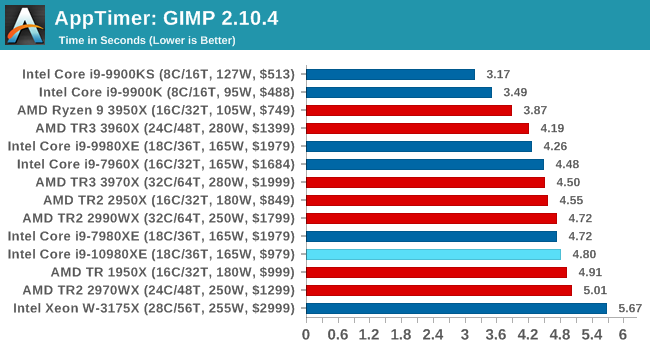
We saw a slight regression here with the 10980XE, which may be down to some of the security updates given that this benchmark tests loading a program which can involve user mode changes.
3D Particle Movement v2.1: Brownian Motion
Our 3DPM test is a custom built benchmark designed to simulate six different particle movement algorithms of points in a 3D space. The algorithms were developed as part of my PhD., and while ultimately perform best on a GPU, provide a good idea on how instruction streams are interpreted by different microarchitectures.
A key part of the algorithms is the random number generation – we use relatively fast generation which ends up implementing dependency chains in the code. The upgrade over the naïve first version of this code solved for false sharing in the caches, a major bottleneck. We are also looking at AVX2 and AVX512 versions of this benchmark for future reviews.
For this test, we run a stock particle set over the six algorithms for 20 seconds apiece, with 10 second pauses, and report the total rate of particle movement, in millions of operations (movements) per second. We have a non-AVX version and an AVX version, with the latter implementing AVX512 and AVX2 where possible.
3DPM v2.1 can be downloaded from our server: 3DPMv2.1.rar (13.0 MB)

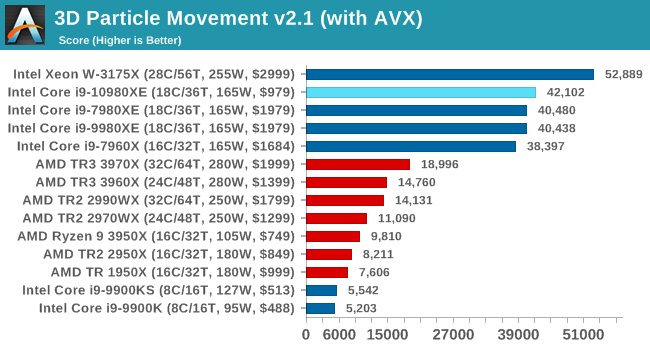
The extra frequency shows a bit here in MT mode, but otherwise equal performance to the 9980XE.
Dolphin 5.0: Console Emulation
One of the popular requested tests in our suite is to do with console emulation. Being able to pick up a game from an older system and run it as expected depends on the overhead of the emulator: it takes a significantly more powerful x86 system to be able to accurately emulate an older non-x86 console, especially if code for that console was made to abuse certain physical bugs in the hardware.
For our test, we use the popular Dolphin emulation software, and run a compute project through it to determine how close to a standard console system our processors can emulate. In this test, a Nintendo Wii would take around 1050 seconds.
The latest version of Dolphin can be downloaded from https://dolphin-emu.org/
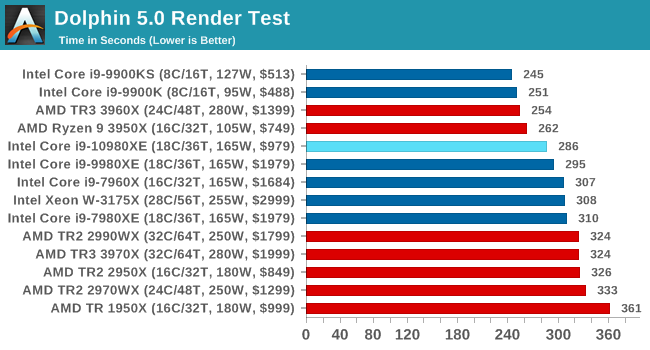
DigiCortex 1.20: Sea Slug Brain Simulation
This benchmark was originally designed for simulation and visualization of neuron and synapse activity, as is commonly found in the brain. The software comes with a variety of benchmark modes, and we take the small benchmark which runs a 32k neuron / 1.8B synapse simulation, equivalent to a Sea Slug.
Example of a 2.1B neuron simulation
We report the results as the ability to simulate the data as a fraction of real-time, so anything above a ‘one’ is suitable for real-time work. Out of the two modes, a ‘non-firing’ mode which is DRAM heavy and a ‘firing’ mode which has CPU work, we choose the latter. Despite this, the benchmark is still affected by DRAM speed a fair amount.
DigiCortex can be downloaded from http://www.digicortex.net/
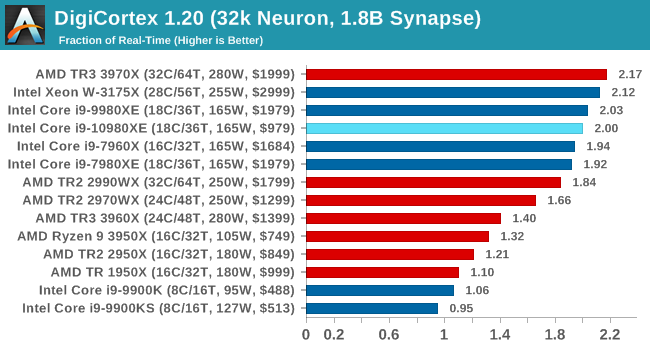
y-Cruncher v0.7.6: Microarchitecture Optimized Compute
I’ve known about y-Cruncher for a while, as a tool to help compute various mathematical constants, but it wasn’t until I began talking with its developer, Alex Yee, a researcher from NWU and now software optimization developer, that I realized that he has optimized the software like crazy to get the best performance. Naturally, any simulation that can take 20+ days can benefit from a 1% performance increase! Alex started y-cruncher as a high-school project, but it is now at a state where Alex is keeping it up to date to take advantage of the latest instruction sets before they are even made available in hardware.
For our test we run y-cruncher v0.7.6 through all the different optimized variants of the binary, single threaded and multi-threaded, including the AVX-512 optimized binaries. The test is to calculate 250m digits of Pi, and we use the single threaded and multi-threaded versions of this test.
Users can download y-cruncher from Alex’s website: http://www.numberworld.org/y-cruncher/

Agisoft Photoscan 1.3.3: 2D Image to 3D Model Conversion
One of the ISVs that we have worked with for a number of years is Agisoft, who develop software called PhotoScan that transforms a number of 2D images into a 3D model. This is an important tool in model development and archiving, and relies on a number of single threaded and multi-threaded algorithms to go from one side of the computation to the other.
In our test, we take v1.3.3 of the software with a good sized data set of 84 x 18 megapixel photos and push it through a reasonably fast variant of the algorithms, but is still more stringent than our 2017 test. We report the total time to complete the process.
Agisoft’s Photoscan website can be found here: http://www.agisoft.com/
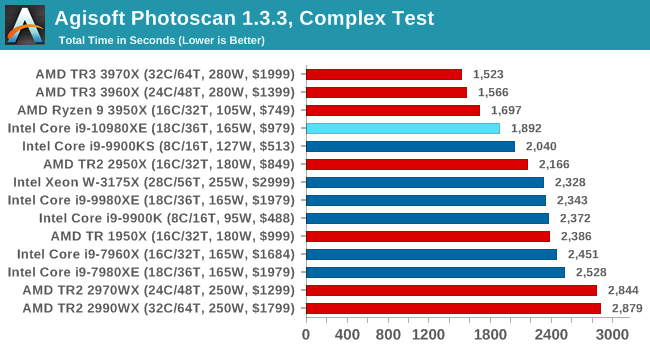
The 10980XE here becomes the fastest Intel CPU we've tested on Photoscal, with a sizeable uplift over the 9980XE. This is likely due to the faster memory.












79 Comments
View All Comments
nt300 - Tuesday, November 26, 2019 - link
Do not thank Intel for anything CPU related. They've been milking consumers for many years, confusing people with several different sockets, chipsets, price points etc., this processor not compatible with that socket and so on. They've caused an industry mess with very expensive CPUs and miniscule IPC increases.Who to thank? AMD for launching ZEN and catching Intel by the surprise.
evernessince - Tuesday, November 26, 2019 - link
While your at bringing up irrelevant points from over 7 years ago, might as well thank AMD for X64 as well. Are you going to fellate Intel for everything they've done in the past?Korguz - Tuesday, November 26, 2019 - link
evernessince dont forget the on die memory controller that intel also copied from amd :-)not irrelevant points, they are valid points.. it kinda proves intel likes to milk people for all they are worth, while stagnating the cpu industry, and over charging for their cpus as well. come on, the top sku for 10xxx cpus is 1k less then the cpu it is replacing, and it cant even do that for the most part, may as well just stick with the 9xxx cpus....
Xyler94 - Wednesday, November 27, 2019 - link
While technically Intel was first to 64bit X86, AMD beat intel to X86-64bit, meaning it was both x86(32bit) and x86(64bit) compatible. Intel tried to go 64bit only, but it backfired on them hard, and so they scrambled to do both 32 and 64 bit, but AMD beat them to the punch, so much so Intel had to license that from AMD, and is the sole reason it's still known today as AMD-64Qasar - Wednesday, November 27, 2019 - link
Xyler94 i remember reading that good old microsoft didnt want to have to code windows for 2 different x86-64 instruction sets, so they made intel drop theirs and adopt AMDs instead, as they had already started programming windows for amd64...Samus - Wednesday, November 27, 2019 - link
You realize the only reason Intel lowered the mainstream bracket to the $300 level was competition from AMD's Black Edition CPU's. And after Ivy Bridge, they shot right back up to $400.So stop pretending Intel doesn't price their products based on competition from AMD. That's just ridiculous.
Beaver M. - Monday, November 25, 2019 - link
Yeah well, lower prices are nice and all, but the product isnt that good.Its still the Skylake architecture, still ancient 14 nm, still has dozens of security flaws.
ksec - Tuesday, November 26, 2019 - link
Thanking AMD for Intel's Price Cut and then continue to buy Intel?JlHADJOE - Tuesday, November 26, 2019 - link
Now W3175X needs to drop down to $2000 for the 32-core TR3 to have any kind of competition.UglyFrank - Monday, November 25, 2019 - link
This could make a great workstation processor for me but AMD is still much compelling.